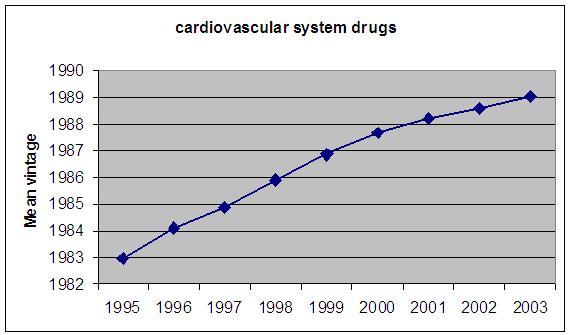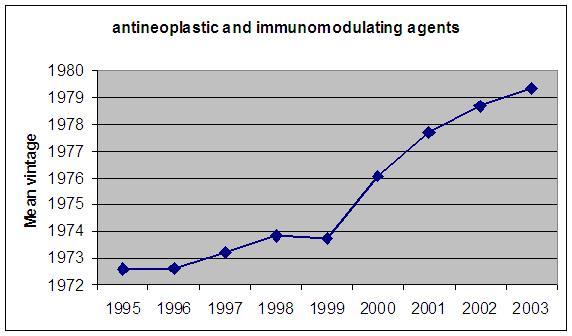Some critics of the pharmaceutical industry (e.g. Angell 2005) claim that most of the new drugs launched by drug companies cost much more than older drugs but are no more effective. If this were the case, then the launch and utilisation of new drugs would not have much impact on health and longevity.
Several previous studies (Lichtenberg 2005a, 2005b) have examined the impact of pharmaceutical innovation on longevity in the United States and in a group of developed and developing countries. Due to data limitations, the measure of pharmaceutical innovation used in these studies was the cumulative number of drugs launched. These studies provided support for the hypothesis that the introduction of new drugs has played an important role in increasing longevity.
In a new study, we examine the impact of pharmaceutical innovation on the longevity of Australians during the period 1995-2003 (Lichtenberg and Duflos 2008). In one important respect, the data available for Australia are much better than those used in the previous studies. Rather than merely knowing whether a given drug has been launched in Australia by a certain date, we know how frequently that drug is used in each year. Combining these data with data from other sources enables us to calculate the mean vintage1 of drugs utilised in Australia, by disease and year.
We used these data to test the hypothesis that, ceteris paribus, people using newer, or later vintage, drugs will be in better health and therefore live longer (die later). This hypothesis is predicated on the idea that pharmaceuticals, like other R&D intensive products, are characterised by embodied technological progress. The hypothesis is tested by determining whether there were above-average increases in mean age at death for diseases with above-average increases in mean vintage of drugs.
New drugs
The level and growth rate of vintage varies considerably across drug classes. Figure 1 depicts the mean vintage of two classes of drugs during 1995-2003. Cardiovascular drugs tend to be much newer than antineoplastic and immunomodulating agents; in 2003 the vintage of the latter was almost 10 years lower. The mean vintage of cardiovascular system drugs increased almost twice as much during the first half of this period (1995-1999) as it did during the second half (1999-2003). In contrast, the mean vintage of antineoplastic and immunomodulating agents increased over four times as much in the second half as it did in the first half.
Figure 1. Mean vintage of two classes of drugs, 1995 - 2003
Our estimates indicate that mean age at death increased more for diseases with larger increases in mean drug vintage, and that increasing the mean vintage of drugs by 5 years would increase mean age at death by almost 11 months. The estimates also indicated that using newer drugs has reduced premature mortality—especially mortality before age 65—in the Australian population. The estimates of three potential years of life lost equations tended to confirm the estimates of the mean age at death equation.
The value of new drugs
Our estimates allowed us to compare the actual increase in mean age at death during the period 1995-2003 to the increase that would have occurred in the absence of any increase in drug vintage. As shown in Figure 2, during this period, mean age at death increased by about 2.0 years, from 74.4 to 76.4. The estimates imply that, in the absence of any increase in drug vintage, mean age at death would have increased by only 0.7 years. The increase in drug vintage accounts for about 65% of the total increase in mean age at death.
Figure 2. Mean age at death with and without drug innovation
We also obtained a rough estimate of the cost per life-year gained from using newer drugs. Under our assumptions, using newer drugs (increasing drug vintage) increased life expectancy by 1.23 years and increased lifetime drug expenditure by $12,976. The cost per life-year gained from using newer drugs is $10,585 (= $12,976/1.23). Viscusi (2005) estimated that the value of a statistical Australian life is 4.2 million USD, which is equal to $A 5.4 million at the current exchange rate (1.2839 $A/USD). This implies that the value of a statistical Australian life-year is $70,618 (=$A 5.4 million / 76.4). This value is 6.7 times as large as our estimate of the cost per life-year gained from using newer drugs.
Sources of uncertainty
For several reasons, our estimate of the cost per life-year gained from using newer drugs could be too high or too low. Several studies have shown that use of newer drugs reduces admissions to hospitals and nursing homes, and increases ability to work. By not accounting for this, we may have overestimated the cost per Australian life-year gained.
Use of newer drugs may have cross-disease spillover effects: using newer drugs for one disease may increase or decrease mortality from other diseases (in part due to “competing risks”). Such spillovers could be either negative or positive. For example, using a newer drug to treat cancer might reduce cancer mortality but increase life-years lost due to cardiovascular disease. On the other hand, using a newer drug to treat depression and other mental disorders might lead to better management of cardiovascular disease.
Finally, innovations in medical devices and procedures, as well as in drugs, have undoubtedly contributed to Australian longevity increase. The models we estimated controlled for device/procedure innovation that is common to all diseases, but not for disease-specific device/procedure innovation: measuring disease-specific device/procedure innovation is far more challenging than measuring disease-specific drug innovation. Since device/procedure innovation may either substitute for or complement drug innovation, controlling for disease-specific device/procedure innovation could either decrease or increase our estimate of the cost per life-year gained from using newer drugs.
Innovative gains
Our findings, which are based on aggregate data, are broadly consistent with previous findings based on individual-level data. Lichtenberg and Virabhak (2007) examined the impact of drug vintage on health and longevity using data on (American) individuals before and after the drugs were consumed. They found that people who used newer drugs had better post-treatment health than people using older drugs for the same condition, controlling for pre-treatment health, age, sex, race, marital status, education, income, and insurance coverage: they were more likely to survive, their perceived health status was higher, and they experienced fewer activity, social, and physical limitations. Most of the health measures indicated that the effect of drug vintage on health is higher for people with low initial health than it is for people with high initial health. This suggests that pharmaceutical-embodied technical progress has a tendency to reduce inequality as well as promote economic growth, broadly defined.
References
Angell, Marcia (2005). The Truth About the Drug Companies: How They Deceive Us and What To Do About It. Random House.
Lichtenberg, Frank (2005a), Pharmaceutical knowledge-capital accumulation and longevity, in Measuring capital in the new economy, ed. by Carol Corrado, John Haltiwanger, and Dan Sichel, 237-269 (University of Chicago Press).
Lichtenberg, Frank (2005b), The impact of new drug launches on longevity: evidence from longitudinal disease-level data from 52 countries, 1982-2001, International Journal of Health Care Finance and Economics 5, 47-73.
Lichtenberg, Frank and Gautier Duflos (2008), “Pharmaceutical innovation and the longevity of Australians: A first look,” NBER Working Paper 14009.
Lichtenberg, Frank, and Suchin Virabhak (2007), “Pharmaceutical-embodied technical progress, longevity, and quality of life: drugs as ‘equipment for your health,’” Managerial and Decision Economics 28: 371–392.
Viscusi, W. Kip. (2005), “The value of life,” Discussion Paper No. 517, Harvard Law School, http://www.law.harvard.edu/programs/olin_center/papers/pdf/Viscusi_517.pdf
Footnotes
1 The dictionary contains several different definitions of vintage. The definition we use is: “a period of origin or manufacture”. We define the vintage of a drug as the year in which the U.S. Food and Drug Administration (FDA) first approved the drug’s active ingredient. (The FDA, which has been in existence since 1938, provides the most complete data on drug vintage.) For example, the vintage of all products (branded and generic) containing simvastatin is 1991, the year this active ingredient was first approved by the FDA. Use of newer drugs results in an increase in drug vintage.






